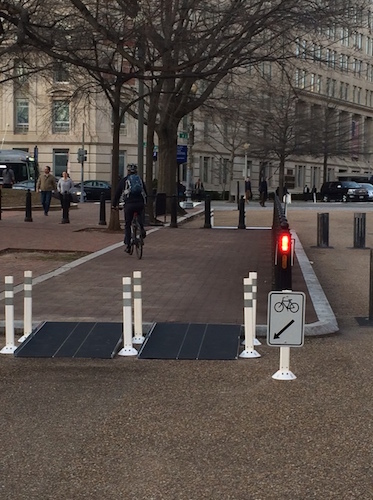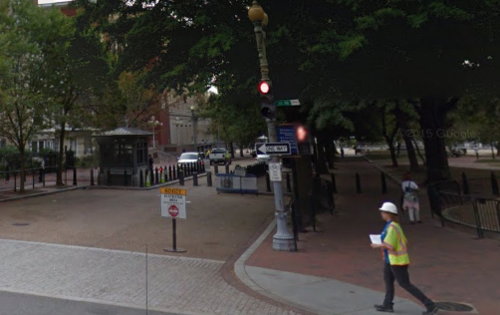New ramps make it easier to bike by the White House
When people biking along the 15th Street protected bikeway reached the White House, they used to have to choose between the sidewalk and a tight squeeze at a security gate. As of this Monday, there’s a route just for bikes.
There are now ramps on both sides of a curb at the entrance to Lafayette Square, making it easy to ride through the area without dismounting. There are also signs indicating that the space is for bikes.
Before the new ramps, the protected bikeway on 15th Street disconnected when it reached the square and the White House grounds.
Much of the route through the square and by the White House is easy to ride because it’s very spacious and there aren’t any cars, but near where the square meets H Street NW, people on bikes had to choose between riding on a brick sidewalk crowded with pedestrians or riding through narrow bollards at a Secret Service checkpoint. Doing this was all the more challenging because there are often multiple cyclists and people on foot at the intersection.
The new ramps make it much easier to pass through.
Even though this is a simple fix, adding the ramps wasn’t exactly easy. The National Park Service maintains Lafayette Square, and the Secret Service has a lot of control over who can actually enter the park, meaning the ramps required approval from a number of parties.
Gregory Billing, the director of the Washington Area Bicyclist Association (WABA), said his agency had been working for a long time to make bicycle access through Lafayette Park easier. He said that WABA is also working on making Pennsylvania Avenue and Lafayette Park less prone to sudden closures by the Secret Service, which force unexpected detours along busy streets.
These ramps are small, but they’re the kind of thing that makes biking easier and a more attractive option for getting around.
DDOT also recently installed a contra-flow lane on one block of M Street NW near the Convention Center, which helps cyclists avoid having to circle the block and ride on the much busier Massachusetts Avenue.
What other small changes could help make riding a bike in the region easier?




